Wave Power Assessment in the Middle Part of the Southern Coast of Java Island
Abstract
:1. Introduction
2. Modeling
2.1. Simulation Domain
2.2. Data Collection and Model Setup
- Wind velocity, u and v components ( and ),
- Significant wave height (),
- Mean wave direction (),
- Wave period (T),
- Bathymetry (h).
2.3. Model Validation
3. Results and Discussion
3.1. Time-Domain Analysis
3.1.1. Yearly Analysis
3.1.2. 15-Year Mean Analysis
3.1.3. Monthly Analysis
3.2. Spatial Analysis
3.2.1. Yogyakarta Coast
3.2.2. Penyu Bay
3.2.3. Nusa Kambangan Coast
3.3. Wave Energy Generation
- The Pelamis is an offshore semi-submerged slack-moored wave energy converter. The device is made of floating cylinders interconnected through hinged sections. The relative wave-induced motion of the cylinders against each other is converted to useful electricity via the hydraulic power take-off (PTO) system placed in the hinged sections [46]. The full scale version of the Pelamis, with rated power of 750 kW, is used in this study. The power matrix of the device is shown in Figure 12a.
- The AquaBuoy is an offshore semi-submerged heaving wave energy converter. The vertical wave-induced motion of the buoy is utilized to pump the sea water into a Pelton turbine, which in turn drives an electric generator [47]. the nameplate power rating of the device is 250 kW and the corresponding power matrix is shown in Figure 12b.
- The Wavebob is an offshore two-body heaving wave energy converter. The relative motion between the floating body and the submerged body is utilized to generate electricity through hydraulic direct-drive PTO system [48]. The full scale version of the Wavebob WEC used in this study is 1000 kW as indicated in the device power matrix depicted in Figure 12c.
4. Conclusions
Author Contributions
Funding
Acknowledgments
Conflicts of Interest
References
- Clement, A.; McCullen, P.; Falcao, A.; Fiorentino, A.; Gardner, F.; Hammarlund, K.; Lemonisa, G.; Lewish, T.; Nielseni, K.; Petroncinij, S.; et al. Wave energy in Europe: Current status and perspectives. Renew. Sustain. Energy Rev. 2002, 6, 405–431. [Google Scholar] [CrossRef]
- Jadidoleslam, N.; Ozger, M.; Agiralioglu, N. Wave power potential assessment of aegean sea with an integrated 15-year data. Renew. Energy 2016, 86, 1045–1059. [Google Scholar] [CrossRef]
- Cruz, J. Ocean Wave Energy Current Status and Future Perspective; Springer: Berlin, Germany, 2008. [Google Scholar]
- Drew, B.; Plummer, A.R.; Sahinkaya, M.N. A review of wave energy converter technology. Proc. Inst. Mech. Eng. Part A J. Power Energy 2009, 223, 887–902. [Google Scholar] [CrossRef] [Green Version]
- Titah-Benbouzid, H.; Benbouzi, M. An up-to-date technologies review and evaluation of wave energy converters. Int. Rev. Electr. Eng. 2015, 1, 52–61. [Google Scholar] [CrossRef]
- Mirzaei, A.; Tangang, F.; Juneng, L. Wave energy potential along the east coast of Peninsular Malaysia. Energy 2014, 68, 1–13. [Google Scholar] [CrossRef]
- Kim, G.; Jeong, W.M.; Lee, K.S.; Jun, K.; Lee, M.E. Offshore and nearshore wave energy assessment around the Korean Peninsula. Energy 2011, 36, 1460–1469. [Google Scholar] [CrossRef]
- Lopez, M.; Veigas, M.; Iglesias, G. On the wave energy resource of Peru. Energy Convers. Manag. 2015, 90, 34–40. [Google Scholar] [CrossRef]
- Besio, G.; Mentaschi, L.; Mazzino, A. Wave energy resource assessment in the Mediterranean Sea on the basis of a 35-year hindcast. Energy 2016, 94, 50–63. [Google Scholar] [CrossRef]
- Ayat, B. Wave power atlas of Eastern Mediterranean and Aegean Seas. Energy 2013, 54, 251–262. [Google Scholar] [CrossRef]
- Liberti, L.; Carillo, A.; Sannino, G. Wave energy resource assessment in the Mediterranean, the Italian perspective. Renew. Energy 2013, 50, 938–949. [Google Scholar] [CrossRef]
- Jadidoleslam, N. Wave Energy Potential Assessment of Aegan Sea. Master’s Thesis, Istanbul Technical University Institute of Science and Technology, Istanbul, Turkey, 2014. [Google Scholar]
- Monteforte, M.; Re, C.L.; Ferreri, G. Wave energy assessment in Sicily (Italy). Renew. Energy 2015, 78, 276–287. [Google Scholar] [CrossRef]
- Morim, J.; Cartwright, N.; Etemad-Shahidi, A.; Strauss, D.; Hemer, M. Wave energy resource assessment along the outheast coast of Australia on the basis of a 31-year hindcast. Appl. Energy 2016, 184, 276–297. [Google Scholar] [CrossRef]
- Hughes, M.; Heap, G. National-scale wave energy resource assessment for Australia. Renew. Energy 2010, 35, 1783–1791. [Google Scholar] [CrossRef]
- Carballo, R.; Iglesias, G. A methodology to determine the power performance of wave energy converters at a particular coastal location. Energy Convers. Manag. 2012, 61, 8–18. [Google Scholar] [CrossRef]
- Rusu, E.; Onea, F. Study on the influence of the distance to shore for a wave energy farm operating in the central part of the Portuguese nearshore. Energy Convers. Manag. 2016, 114, 209–223. [Google Scholar] [CrossRef]
- Silva, D.; Martinho, P.; Shares, C. Wave energy distribution along the portuguese continental coast based on a thirty-three years hindcast. Renew. Energy 2020, 127, 1064–1075. [Google Scholar] [CrossRef]
- Astariz, S.; Iglesias, G. Selecting optimum locations for co-located wave and wind energy farms. Part I: The co-location feasibility index. Energy Convers. Manag. 2016, 122, 589–598. [Google Scholar] [CrossRef] [Green Version]
- Contestabile, P.; Ferrante, V.; Vicinanza, D. Wave energy resource along the coast of Santa Catarina (Brazil). Energies 2015, 8, 14219–14243. [Google Scholar] [CrossRef] [Green Version]
- Aboobacker, V.M.; Shanas, P.R.; Alsaafani, M.A.; Albarakati, A.M. Wave energy resource assessment for Red Sea. Renew. Energy 2017, 114, 46–58. [Google Scholar] [CrossRef]
- Langodan, S.; Viswanadhapalli, Y.; Dasari, H.P.; Knio, O.; Hoteit, I. A high-resolution assessment of wind and wave energy potentials in the Red Sea. Appl. Energy 2016, 181, 244–255. [Google Scholar] [CrossRef]
- Akpinar, A.; Komurucu, M.I. Assessment of wave energy resource of the Black Sea based on 15-year numerical hindcast data. Appl. Energy 2013, 101, 502–512. [Google Scholar] [CrossRef]
- Contestabile, P.; Di Lauro, E.; Galli, P.; Corselli, C.; Vicinanza, D. Offshore wind and wave energy assessment around male and magoodhoo island (maldives). Sustainability 2017, 9, 613. [Google Scholar] [CrossRef] [Green Version]
- Ribal, A.; Zieger, S. Wave energy resource assessment based on satellite observations around Indonesia. In Proceedings of the 3rd AUN/SEED-NET Regional Conference on Energy Engineering and the 7th International Conference on Thermofluids (RCEnE/THERMOFLUID 2015), Yogyakarta, Indonesia, 19–20 November 2015; AIP: College Park, MD, USA, 2016; pp. 1–13. [Google Scholar]
- Wahyudie, A.; Susilo, T.B.; Aryani, F.; Nandar, C.; Jama, M.; Daher, A. Ocean wave power potential assessment along the South Coast of Central Java Island Indonesia. In Proceedings of the OCEANS 2017, Anchorage, AK, USA, 18–21 September 2017; pp. 1–6. [Google Scholar]
- Rusu, E.; Onea, F. Evaluation of the wind and wave energy along the Caspian Sea. Energy 2013, 50, 1–14. [Google Scholar] [CrossRef]
- Mazarakis, N.; Kotroni, V.; Lagouvardos, K.; Bertotti, L. High-resolution wave model validation over the Greek maritime areas. Nat. Hazzards Earth Syst. Sci. 2012, 12, 3433–3440. [Google Scholar] [CrossRef] [Green Version]
- Tharakan, P. Summary of indonesian’s energy sector assessment. Asian Dev. Bank 2015, 9, 1–40. [Google Scholar]
- Hidayat, M.N.; Li, F. Implementation of renewable energy sources for electricity generation in Indonesia. In Proceedings of the 2011 IEEE Power and Energy Society General Meeting, Detroit, MI, USA, 24–28 July 2011. [Google Scholar]
- Winarno, O.T.; Alwendra, Y.; Mujiyanto, S. Implementation of renewable energy sources for electricity generation in Indonesia policies and strategies for renewable energy development in Indonesia. In Proceedings of the 2011 IEEE Power and Energy Society General Meeting, Detroit, MI, USA, 24–28 July 2011; IEEE: Piscataway, NJ, USA, 2011. [Google Scholar]
- Wijaya, F.D.; Rifa’i, M.; Kukuh, D.P. Design optimization of tri core pm linear generator using sa and fpa for wave energy conversion system in south coast of Java Island. In Proceedings of the 2016 2nd International Conference on Science and Technology-Computer (ICST), Yogyakarta, Indonesia, 27–28 October 2016. [Google Scholar]
- BPPT. Indonesia Energy Outlook 2016; BPPT: Jakarta, Indonesia, 2016.
- Zikra, M. Preliminary assessment of wave energy potential around Indonesia Sea. Appl. Mech. Mater. 2017, 862, 55–60. [Google Scholar] [CrossRef]
- Guanche, R.; de Andres, A.; Losada, I.J.; Vidal, C. A global analysis of the operation and maintenance role on the placing of wave energy farms. Energy Convers. Manag. 2015, 106, 440–456. [Google Scholar] [CrossRef]
- Kovaleva, O.; Eelsalu, M.; Soomere, T. Hot-spots of large wave energy resources in relatively sheltered sections of the baltic Sea coast. Renew. Sustain. Energy Rev. 2017, 74, 424–437. [Google Scholar] [CrossRef]
- MIKE-DHI. MIKE 21 Wave Modelling; DHI: Horsholm, Denmark, 2016. [Google Scholar]
- ECMWF. ERA Interim Daily. Available online: http://apps.ecmwf.int/datasets/data/interim-full-daily/levtype=sfc/ (accessed on 22 February 2017).
- GEBCO. Gridded Bathymetry Data. Available online: http://www.gebco.net/data_and_products/gridded_bathymetry_data/ (accessed on 22 February 2017).
- BPPT. Pusat Data Buoy Indonesia. Available online: http://bpptbuoy.info/pdbi/ (accessed on 22 February 2017).
- MIKE-DHI. MIKE 21 Spectral Wave Module Scientific Documentation; DHI: Horsholm, Denmark, 2017. [Google Scholar]
- Eldeberky, Y.; Battjes, J.A. Spectral modeling of wave breaking: Application to Boussinesq equations. J. Geophys. Res. 1996, 101, 1253–1264. [Google Scholar] [CrossRef]
- Hasselmann, K. On the spectral diffipation of ocean waves due to white capping. Bound. Layer Meteorol. 1974, 6, 107–127. [Google Scholar] [CrossRef]
- Bidlot, J.; Janssen, P.; Abdalla, S. A Revised Formulation for Ocean Wave Dissipation in CY19R1; Technical Report Memorandum 509; ECMWF: Reading, UK, 2007. [Google Scholar]
- Ozger, M.; Altunkaynak, A.; Sen, Z. Statistical investigation of expected wave energy and its reliability. Energy Convers. Manag. 2004, 45, 2173–2185. [Google Scholar] [CrossRef]
- Henderson, R. Design, simulation, and testing of a novel hydraulic power take-off system for the Pelamis wave energy converter. Renew. Energy 2006, 31, 271–283. [Google Scholar] [CrossRef]
- Weinstein, A.; Fredrikson, G.; Parks, M.; Nielsen, K. AquaBuOY—The Offshore Wave Energy Converter Numerical Modeling and Optimization. In Proceedings of the Oceans 2003, San Diego, CA, USA, 22–26 September 2003. [Google Scholar]
- Babarit, A.; Hals, J.; Muliawan, M.; Kurniawan, A.; Moan., T.; Krokstad, J. Numerical benchmarking study of a selection of wave energy converters. Renew. Energy 2012, 41, 44–63. [Google Scholar] [CrossRef]
- Morim, J.; Cartwright, N.; Hemer, M.; Etemad-Shahidi, A. Darrell Strauss Inter- and intra-annual variability of potential power production from wave energy converters. Energy 2019, 169, 1224–1241. [Google Scholar] [CrossRef]
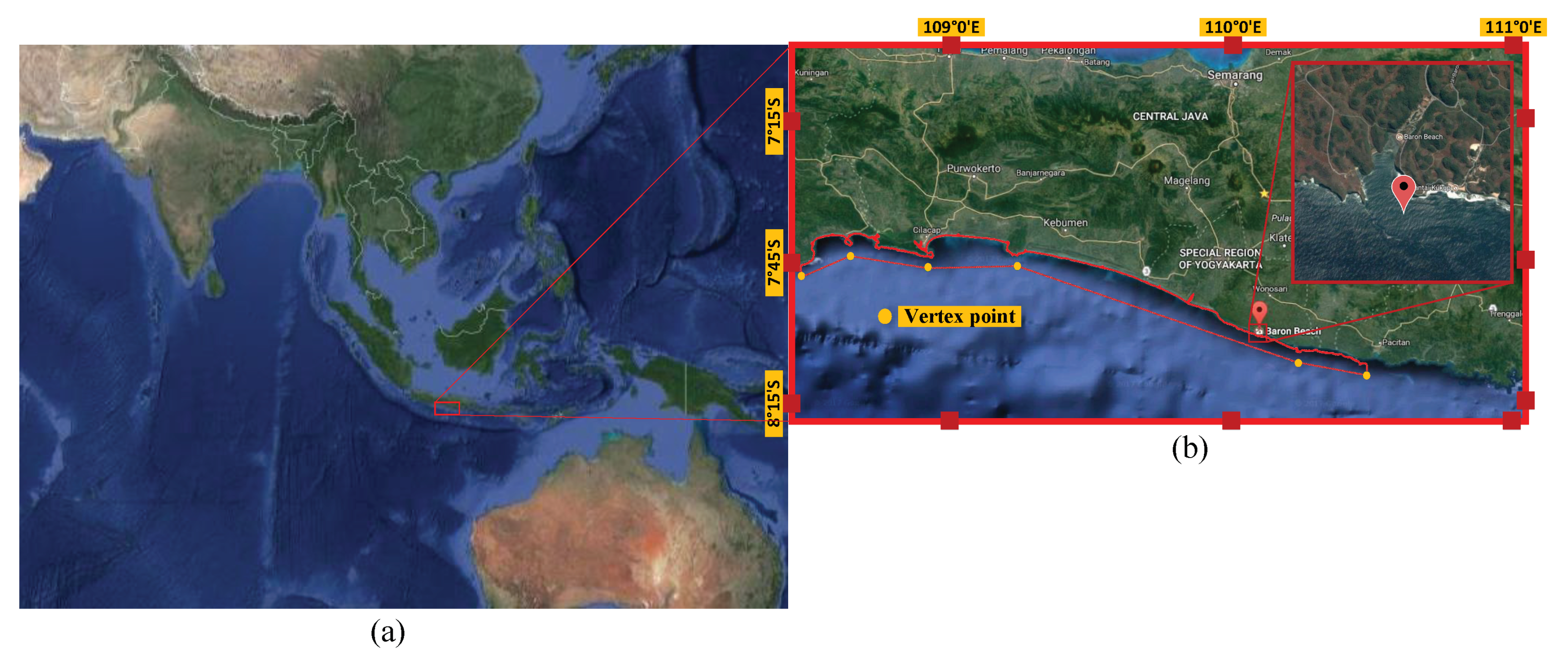
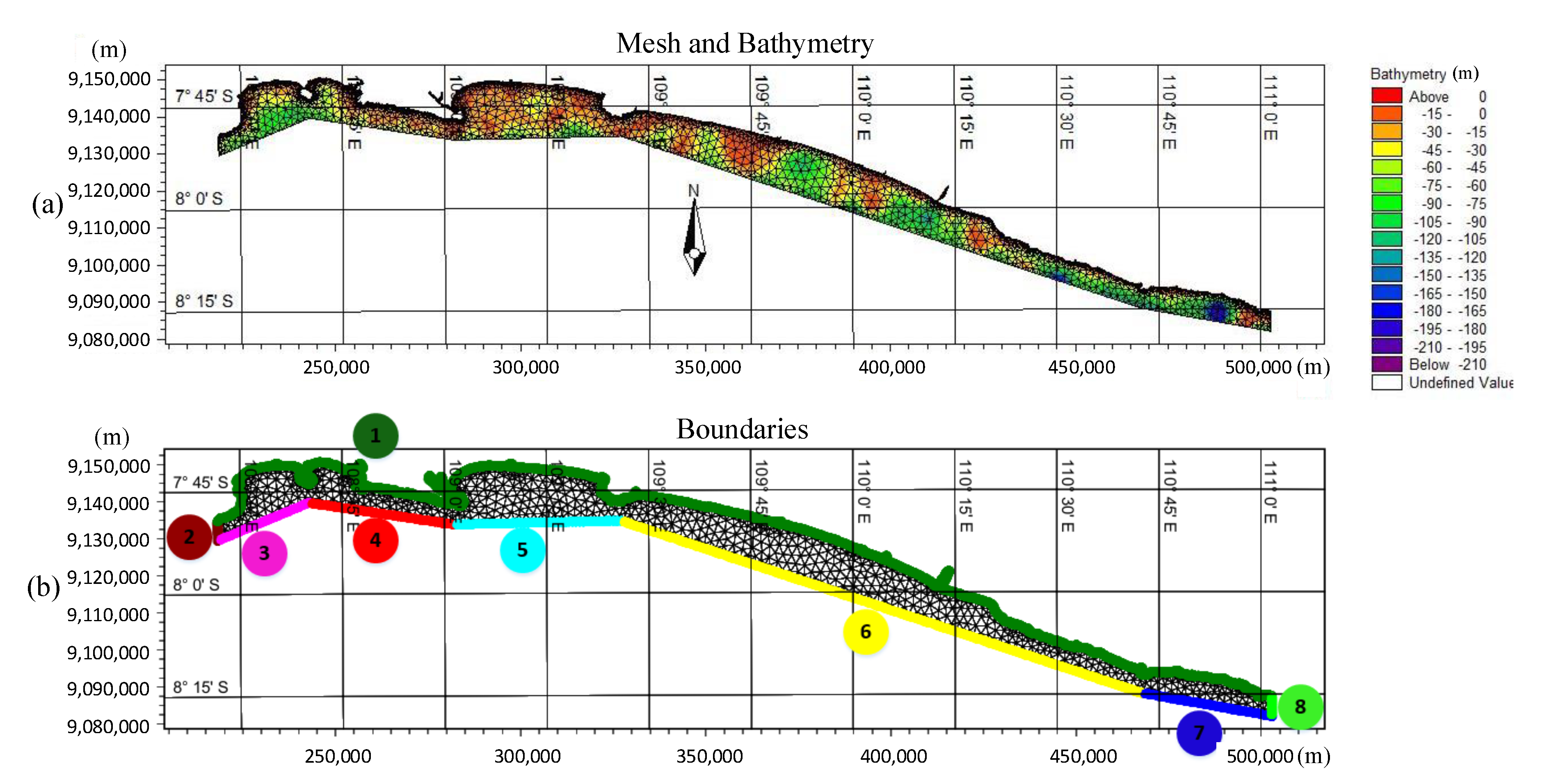
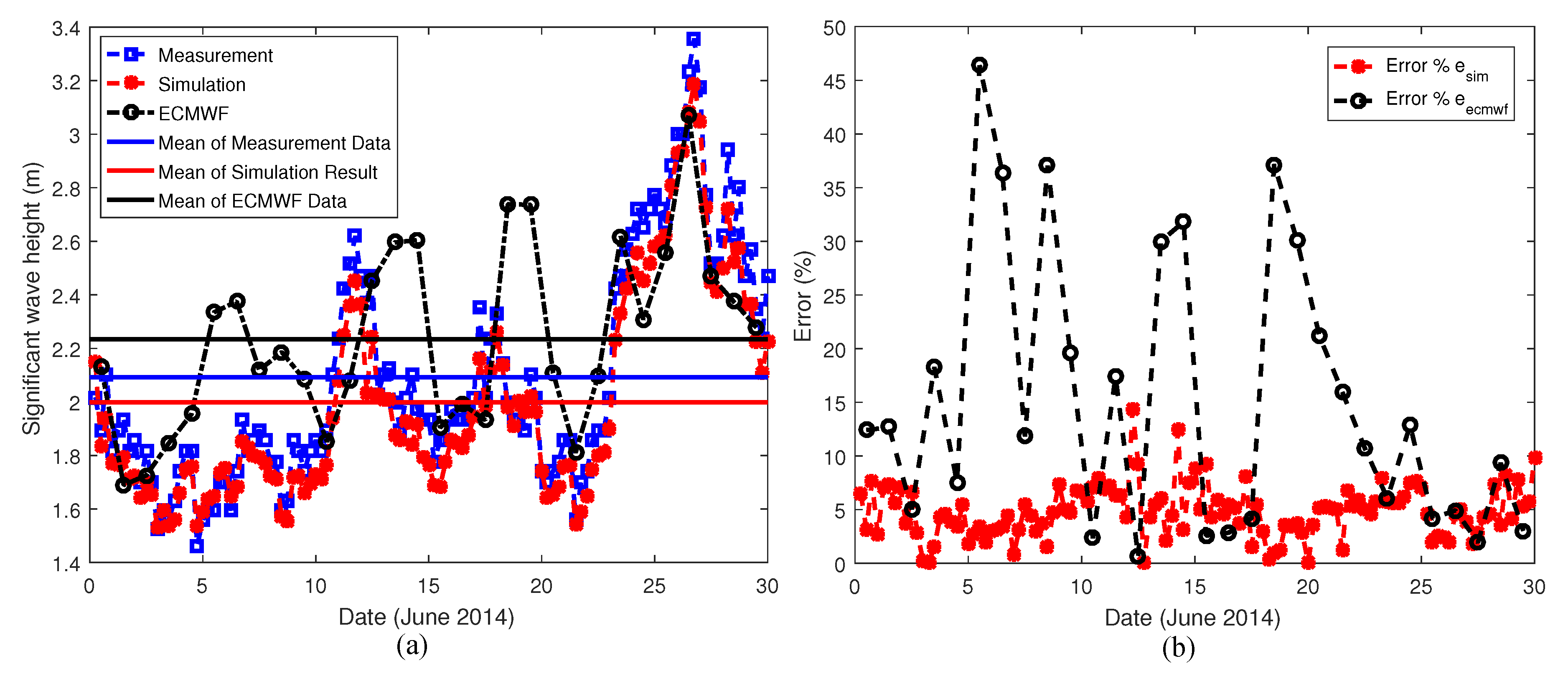
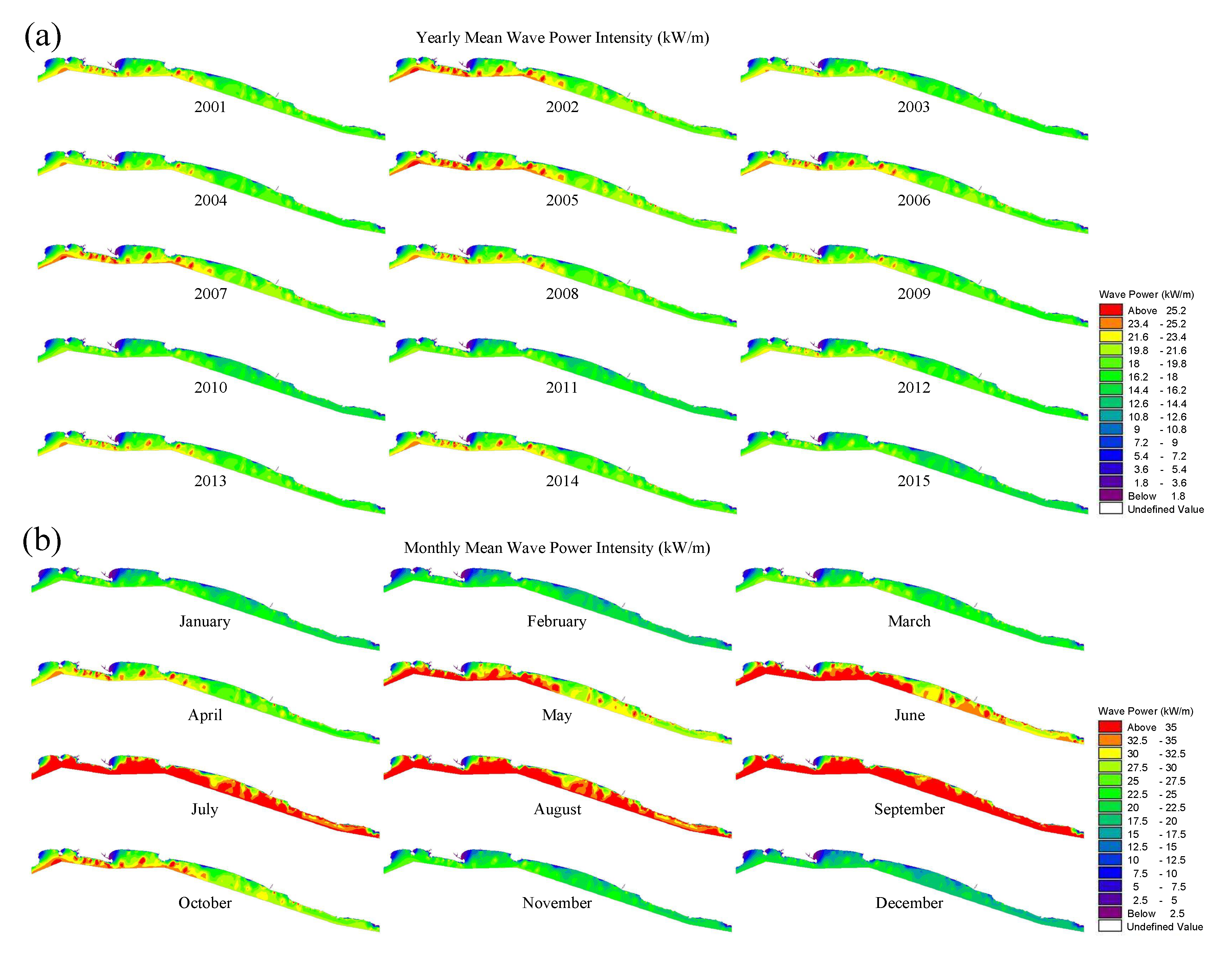
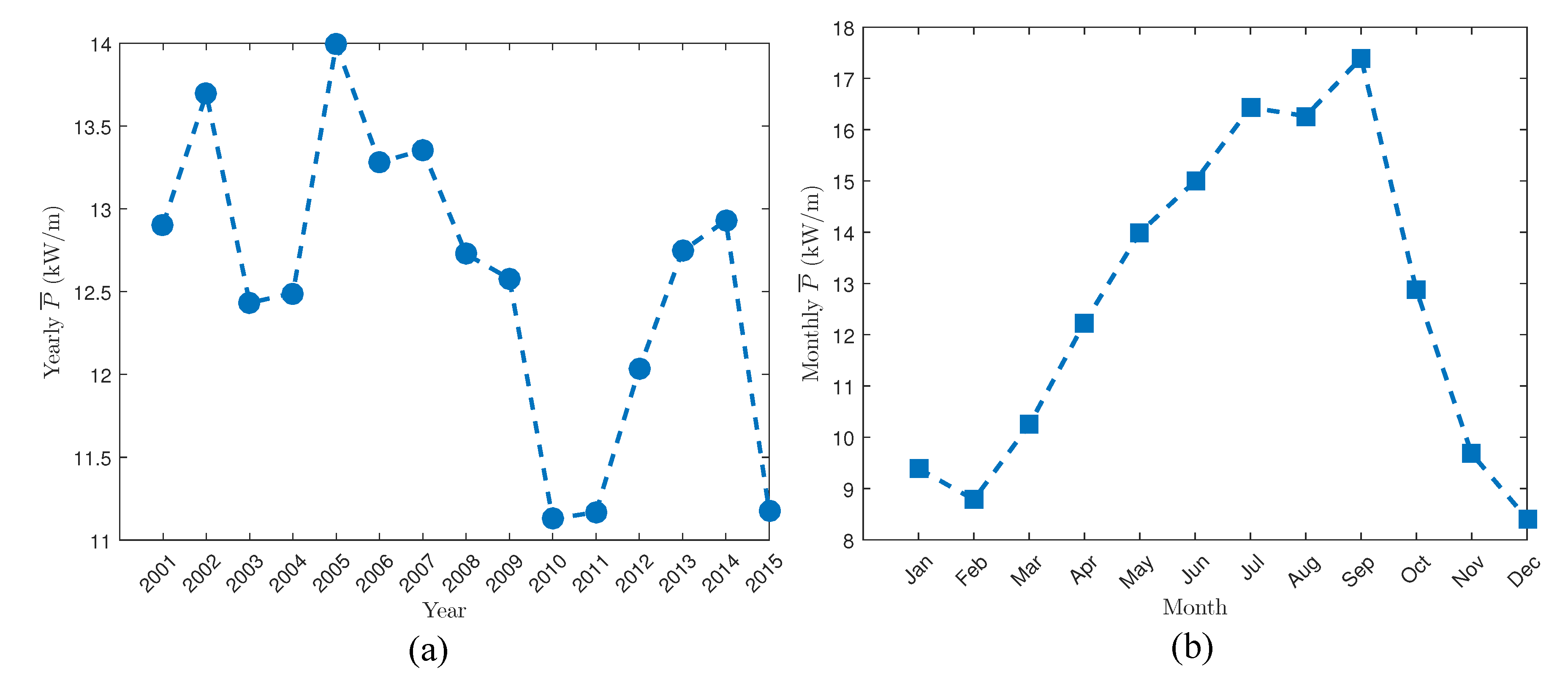

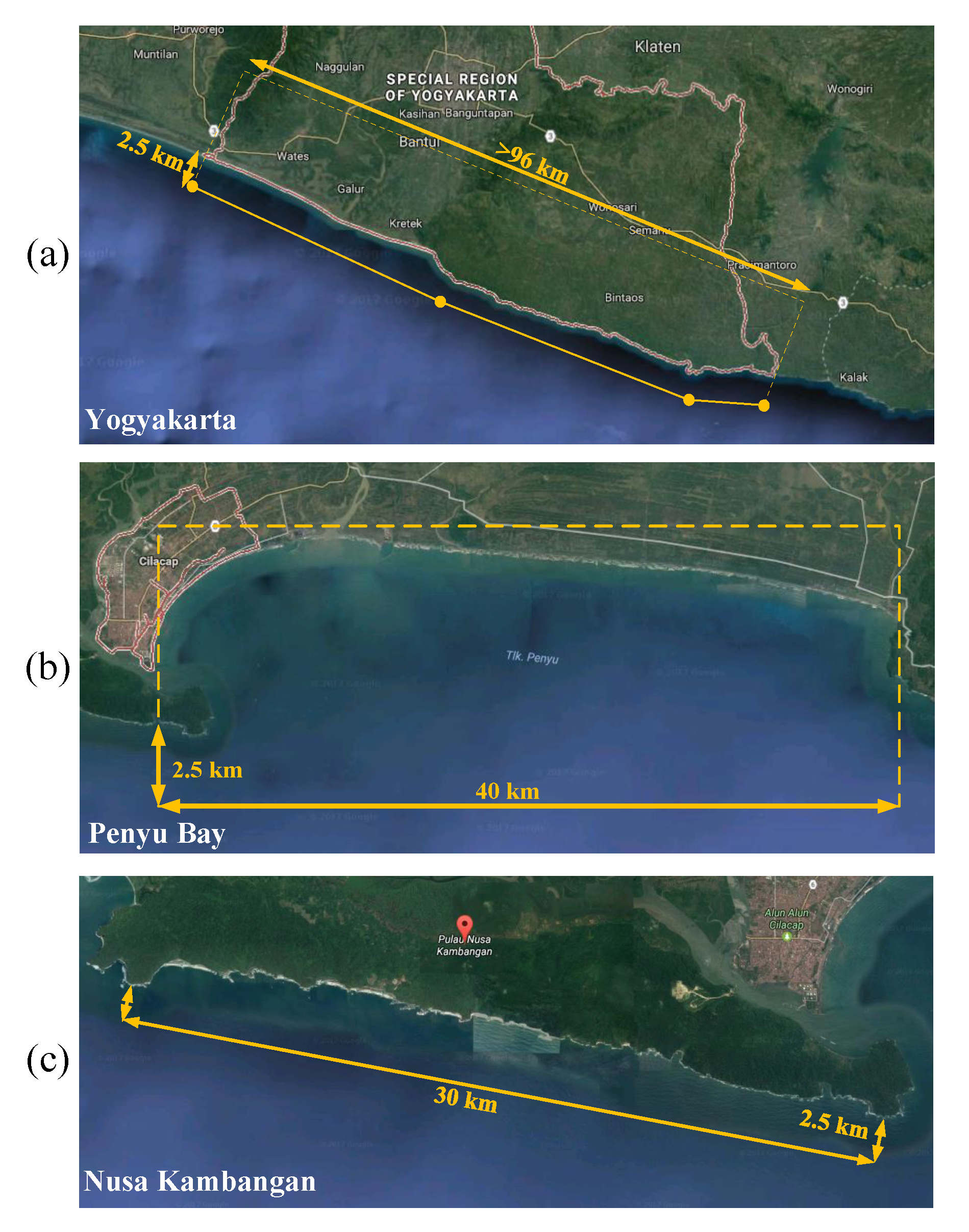
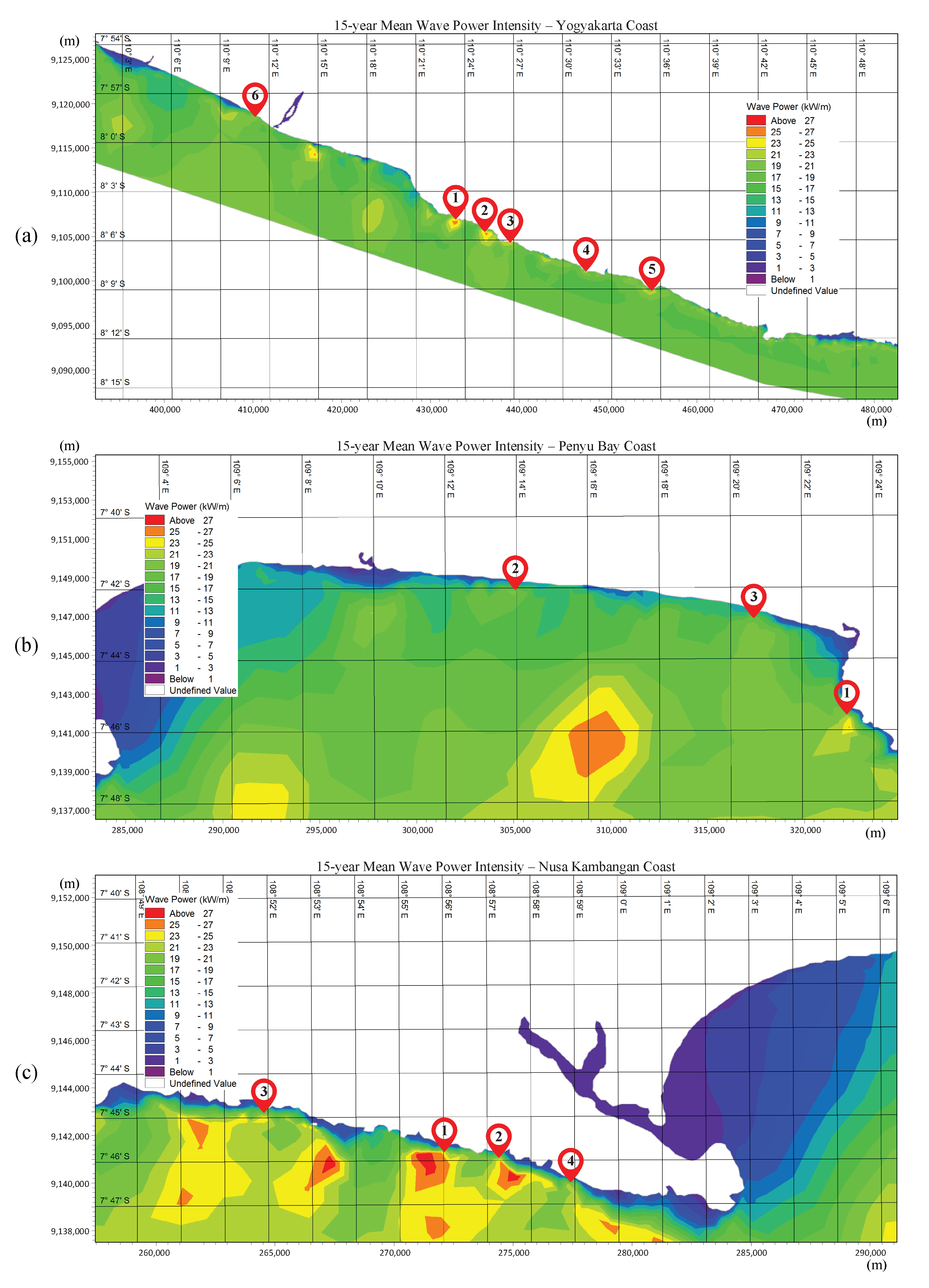
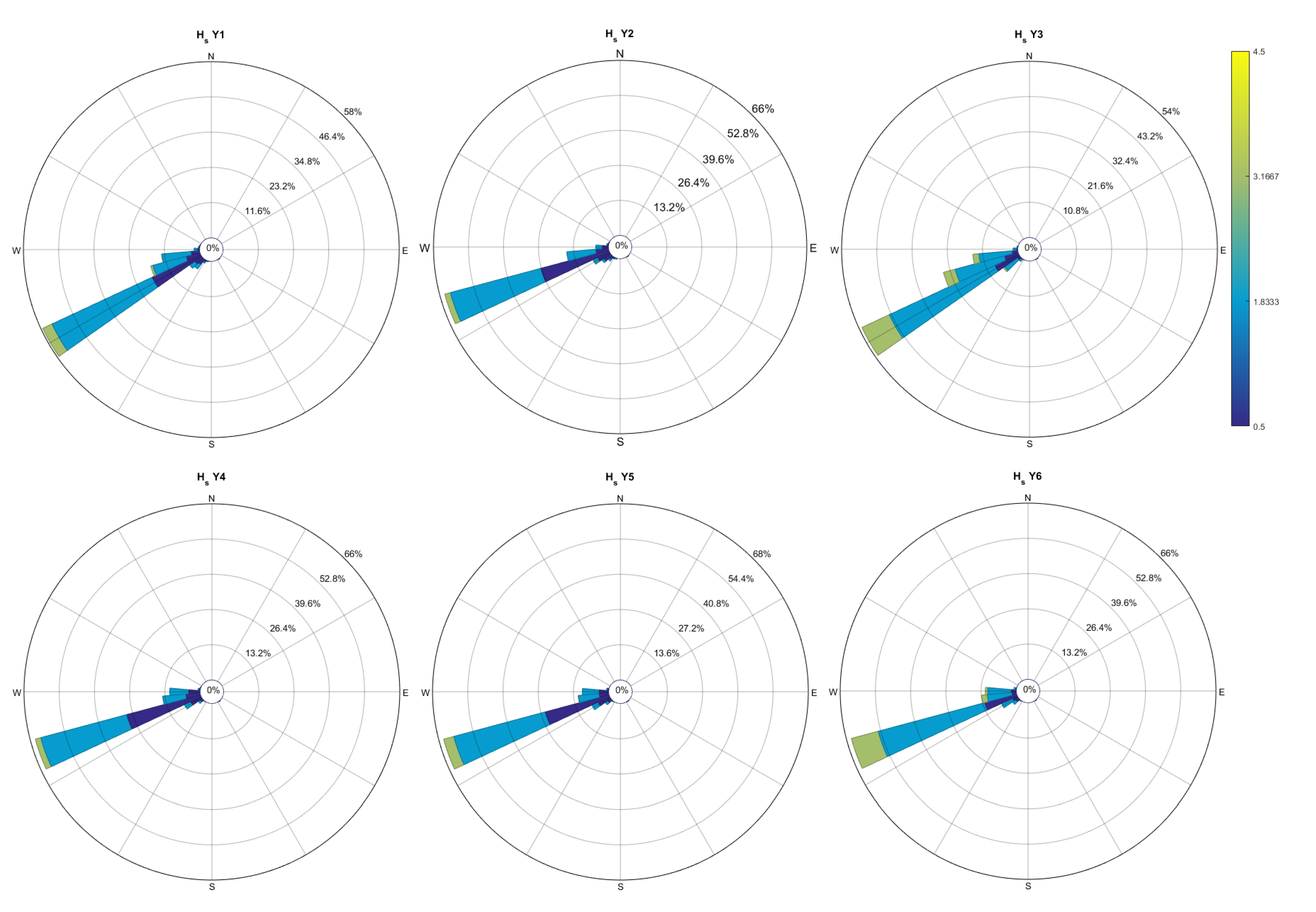
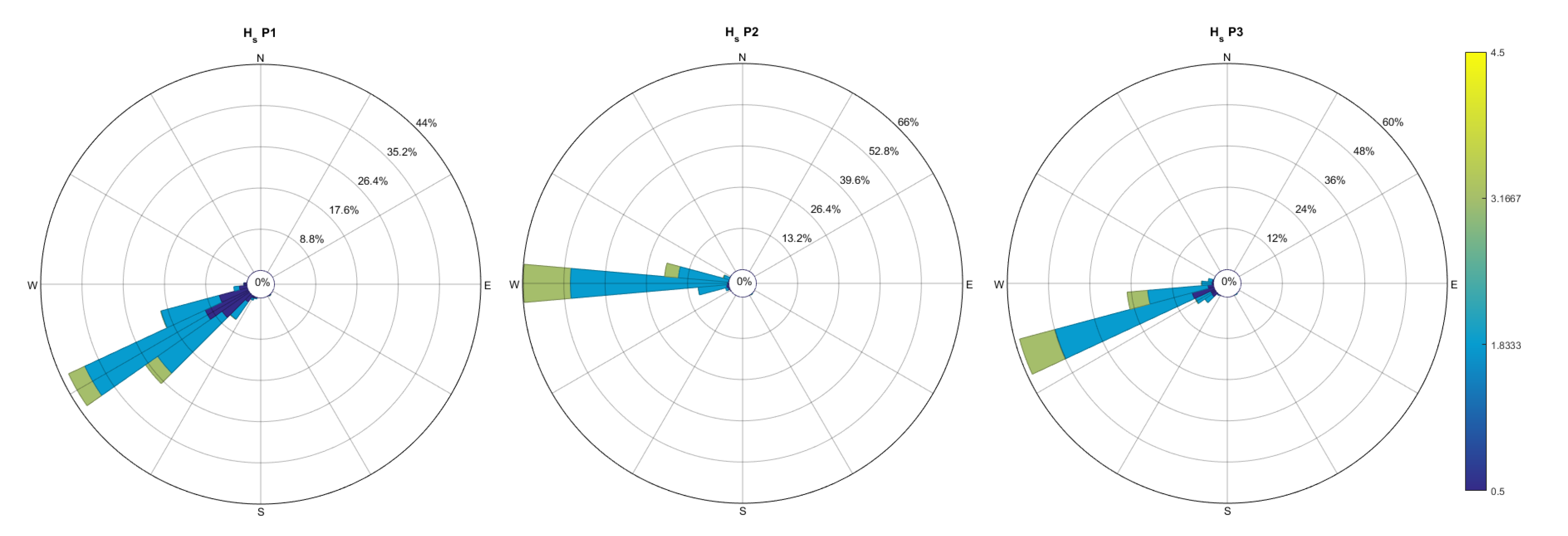
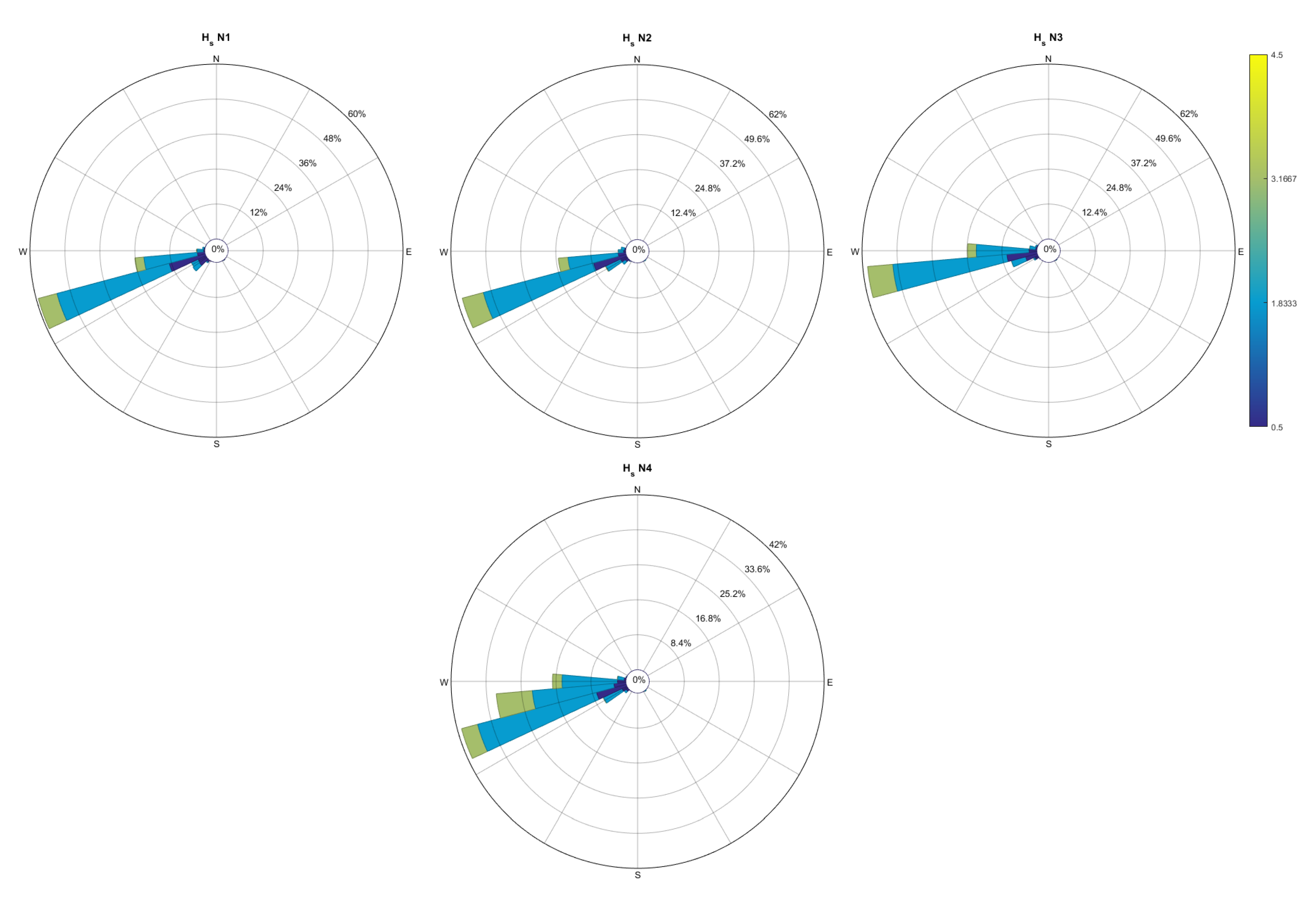
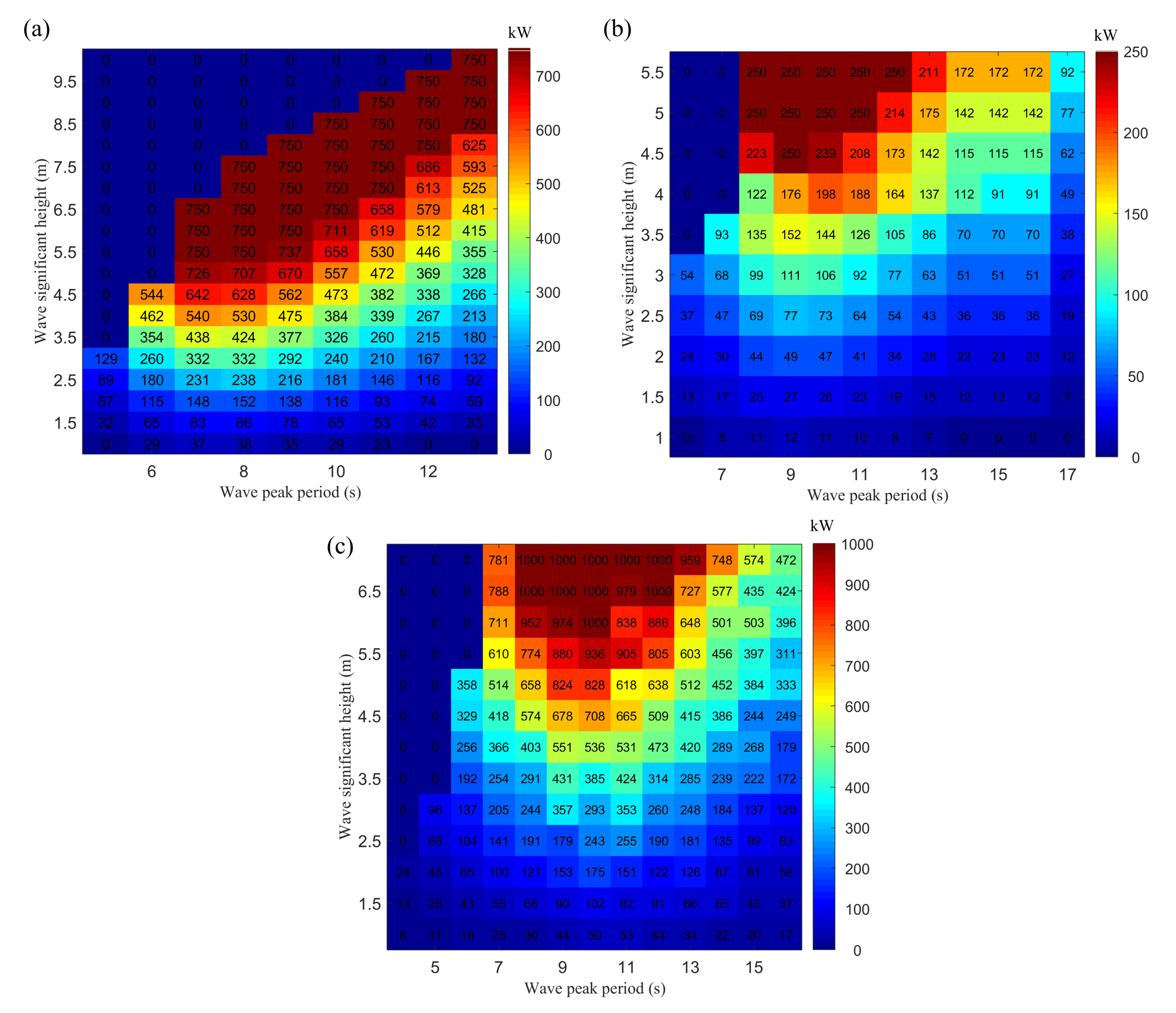
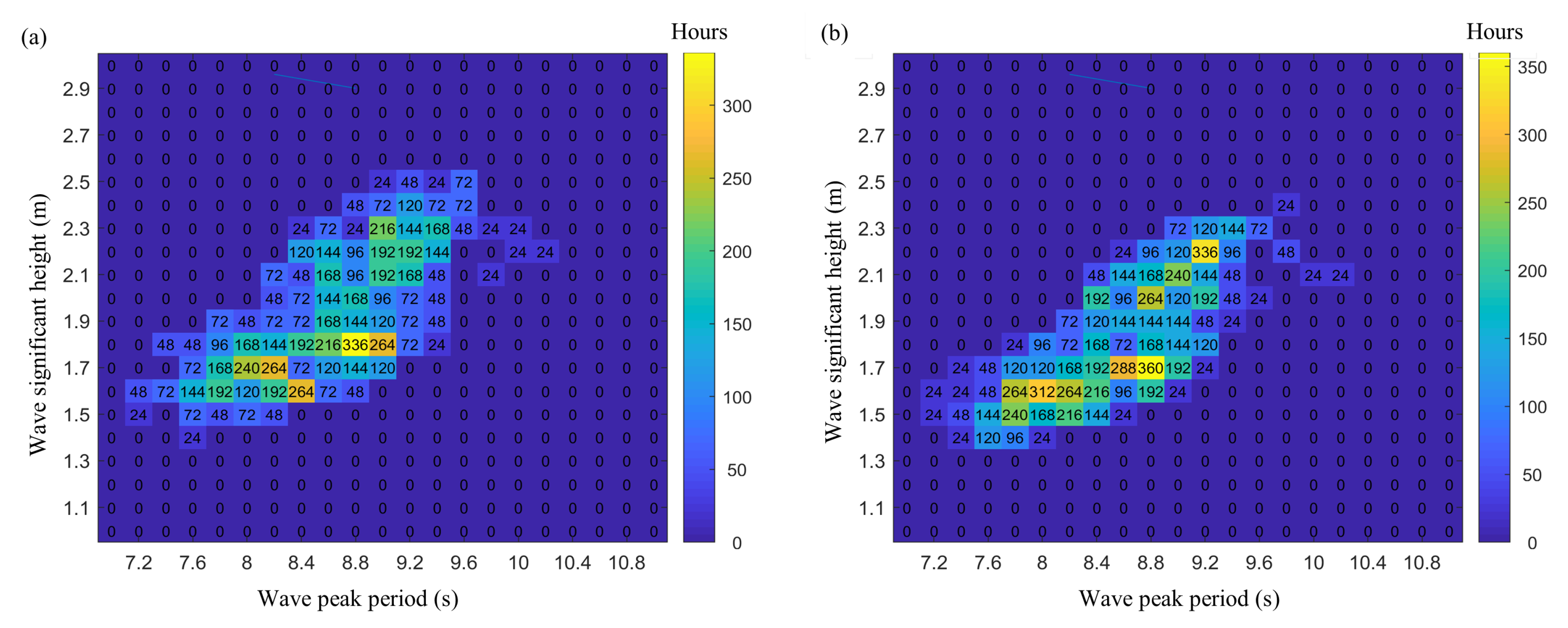
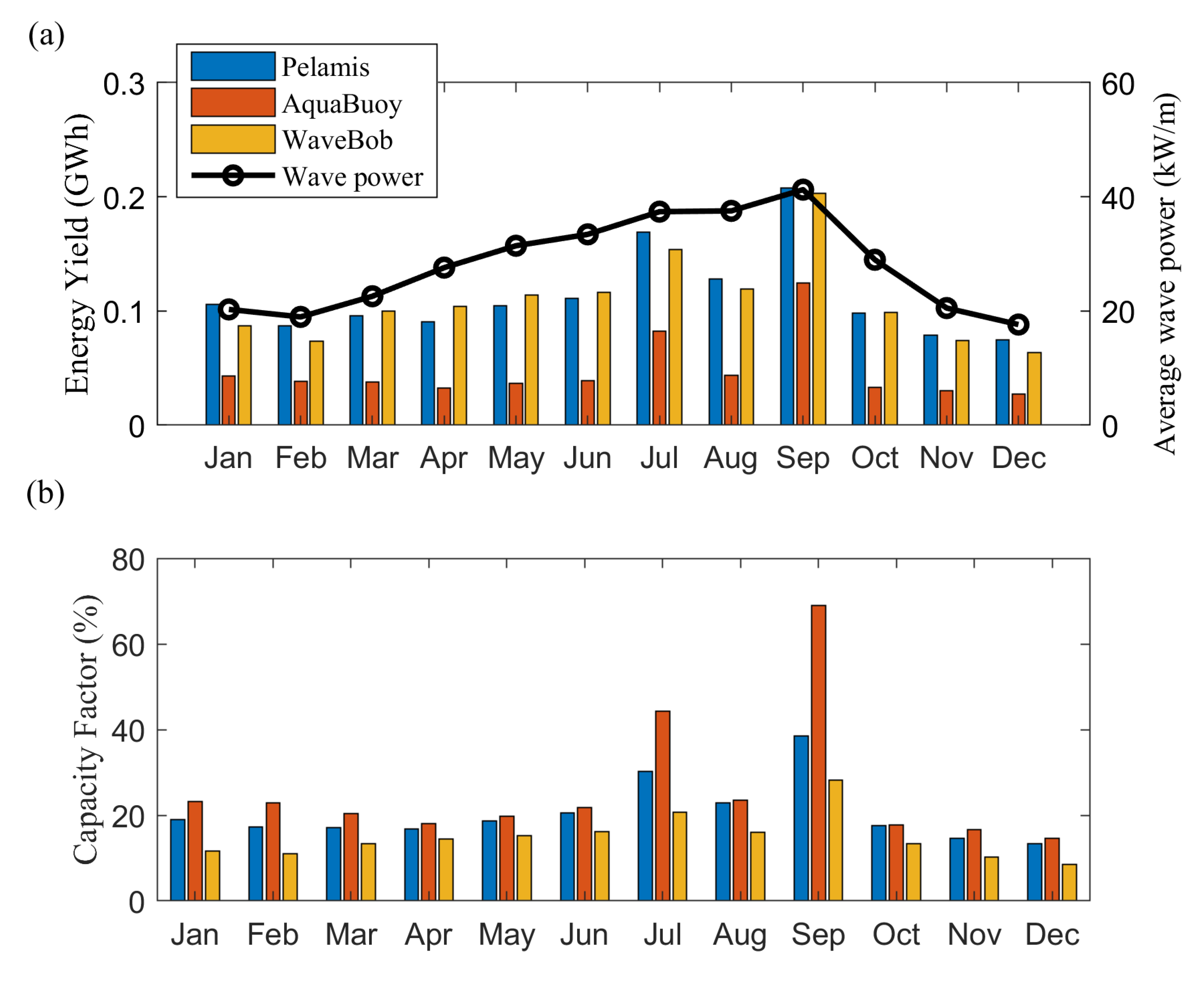
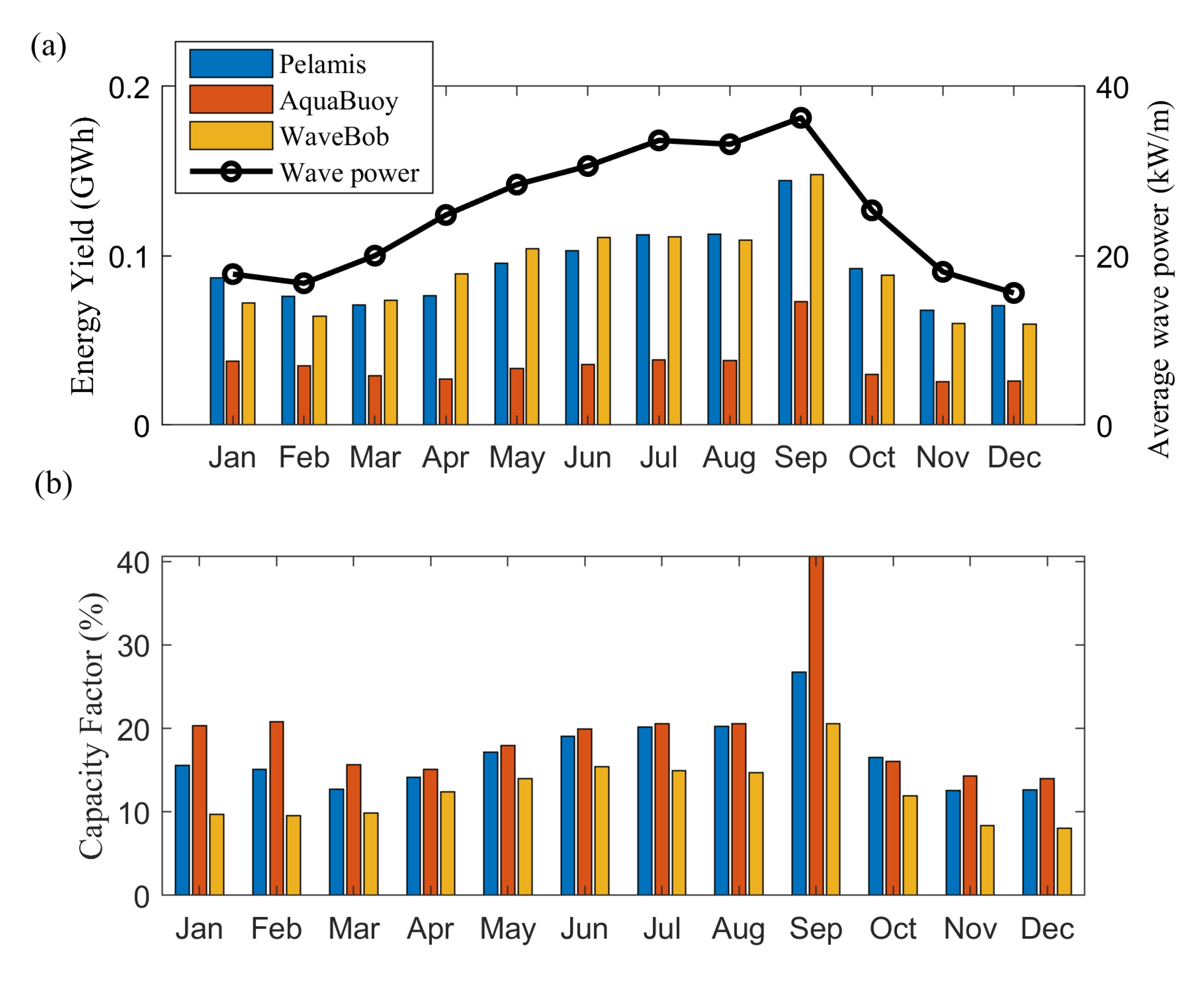
| Setting Parameter of the Spectral Wave Model in MIKE 21 SW | Setting Value | ||
|---|---|---|---|
| Spectral Discret. | Frequency discretization | Type | Logarithmic |
| Number of frequency | 25 | ||
| Minimum frequency | 0.05 | ||
| Frequency factor | 1.1 | ||
| Directional discretization | Type | 360° rose | |
| Number or direction | 16 | ||
| Solution Technique | Instationary formulation | Geographical discretization | Higher order |
| Maximum number of | 32 | ||
| levels in transport calculation | |||
| Number of step of source calc. | 1 | ||
| Minimum time step | 0.01 s | ||
| Maximum time step | 30 s | ||
| Wind forcing | Type | u and v components | DFS2 format |
| Energy forcing | Type | Quadruplet wave interaction | - |
| Wave Breaking | Breaking Coffesient () | Constant | 0.8 |
| Calibration constant () | Constant | 1 | |
| Bottom Friction | Nikuradse roughness () | Constant | 0.04 |
| White Capping | Dissipation coefficients | Constant | 2 and 0.8 |
| ( and ) | |||
| Location | Latitude (°S) | Longitude (°E) | (kW/m) | (m) | (s) | d (m) | h (m) |
|---|---|---|---|---|---|---|---|
| Yogyakarta Coast | |||||||
| 1 | 8.079190 | 110.390709 | 30 | 2.0 | 8.9 | 150 | 35 |
| 2 | 8.090876 | 110.424812 | 30 | 2.0 | 9.1 | 250 | 55 |
| 3 | 8.101757 | 110.439587 | 27 | 2.0 | 8.9 | 150 | 30 |
| 4 | 8.131859 | 110.522797 | 24.8 | 1.9 | 8.6 | 125 | 30 |
| 5 | 8.146277 | 110.582598 | 24.8 | 1.9 | 8.9 | 175 | 22 |
| 6 | 7.972976 | 110.184429 | 22.5 | 1.8 | 8.8 | 200 | 22 |
| Penyu Bay Coast | |||||||
| 1 | 7.758631 | 109.386500 | 25.5 | 1.9 | 8.8 | 200 | 72 |
| 2 | 7.699657 | 109.230078 | 22.5 | 1.8 | 8.8 | 400 | 10 |
| 3 | 7.715494 | 109.344885 | 21 | 1.6 | 8.8 | 550 | 18 |
| Nusa Kambangan Coast | |||||||
| 1 | 7.762734 | 108.933951 | 27.5 | 2.0 | 9.2 | 250 | 26 |
| 2 | 7.765251 | 108.953376 | 27 | 2.0 | 8.9 | 200 | 36 |
| 3 | 7.747749 | 108.865256 | 27 | 2.0 | 9.0 | 250 | 23 |
© 2020 by the authors. Licensee MDPI, Basel, Switzerland. This article is an open access article distributed under the terms and conditions of the Creative Commons Attribution (CC BY) license (http://creativecommons.org/licenses/by/4.0/).
Share and Cite
Wahyudie, A.; Susilo, T.B.; Alaryani, F.; Nandar, C.S.A.; Jama, M.A.; Daher, A.; Shareef, H. Wave Power Assessment in the Middle Part of the Southern Coast of Java Island. Energies 2020, 13, 2633. https://doi.org/10.3390/en13102633
Wahyudie A, Susilo TB, Alaryani F, Nandar CSA, Jama MA, Daher A, Shareef H. Wave Power Assessment in the Middle Part of the Southern Coast of Java Island. Energies. 2020; 13(10):2633. https://doi.org/10.3390/en13102633
Chicago/Turabian StyleWahyudie, Addy, Tri Bagus Susilo, Fatima Alaryani, Cuk Supriyadi Ali Nandar, Mohammed Abdi Jama, Abdulrahman Daher, and Hussain Shareef. 2020. "Wave Power Assessment in the Middle Part of the Southern Coast of Java Island" Energies 13, no. 10: 2633. https://doi.org/10.3390/en13102633
APA StyleWahyudie, A., Susilo, T. B., Alaryani, F., Nandar, C. S. A., Jama, M. A., Daher, A., & Shareef, H. (2020). Wave Power Assessment in the Middle Part of the Southern Coast of Java Island. Energies, 13(10), 2633. https://doi.org/10.3390/en13102633





